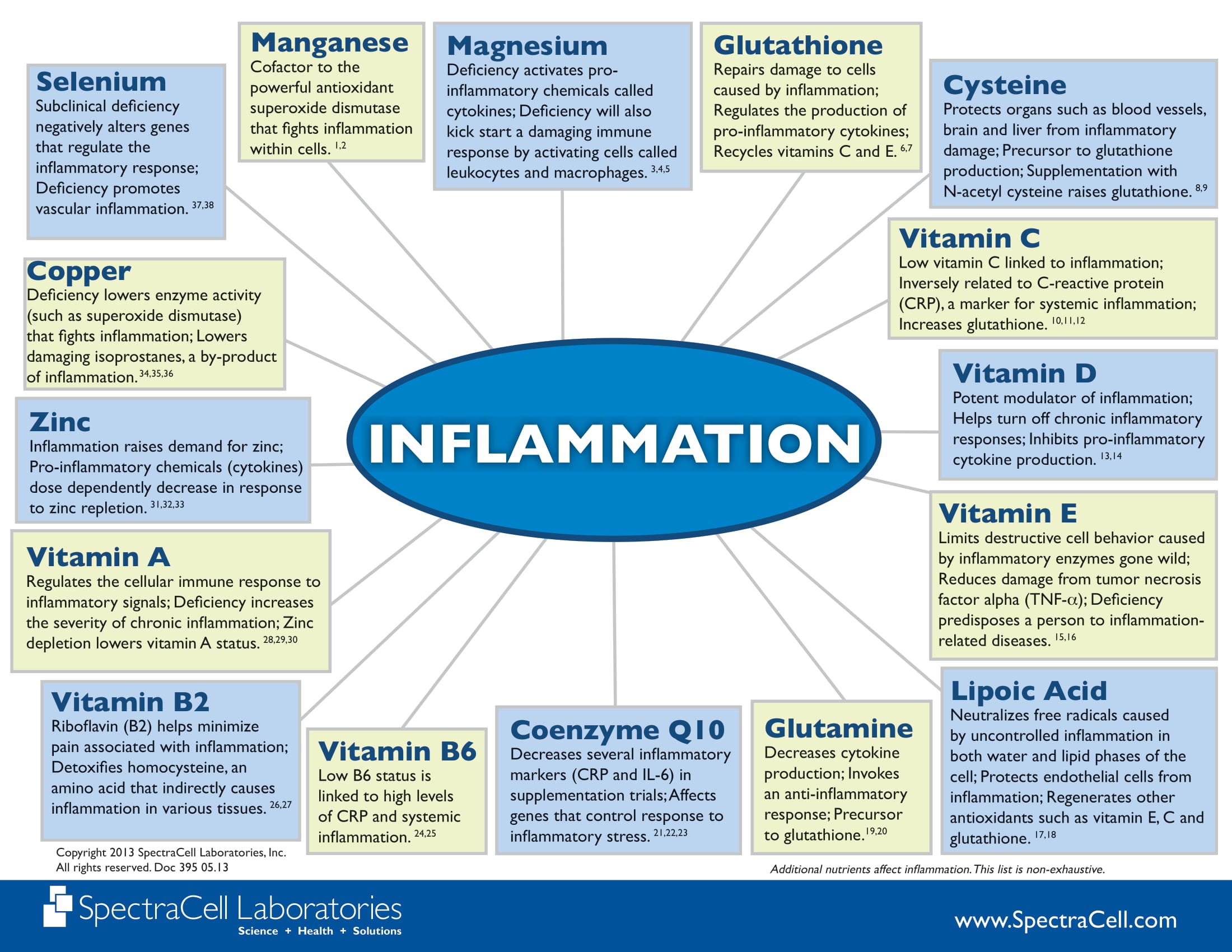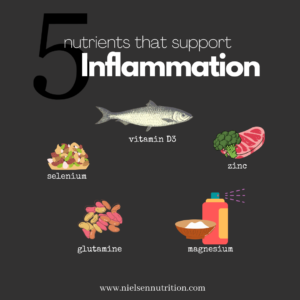22 Nov Is your inflammation worsened by nutrient deficiencies?
Nutrients and Inflammation
A nutrient dense diet along with proper digestive function is essential for maintaining a healthy body. Chronic inflammation is a complex topic and we work with our clients to create customized plans to tackle this health concern because no two people are the same! When we look at the current research on inflammation and nutrition there are clear deficiencies that contribute to a highjacked inflammatory response.
Here are some examples of the most common deficiencies we see in our practice.
- Selenium: activates vitamin C, enhances immunity, is important in thyroid health, and functions as an antioxidant in the body. Selenium content in grains and vegetables vary based on the water and soil content where these foods are grown. Good sources of selenium include nuts, seafood and meat and the most reliable source of selenium is Brazil Nuts.
- Zinc: an important mineral responsible for over 300 enzymes in the body and is involved in
growth, reproduction, and immunity. Good sources of zinc include shellfish, organ meat, and
animal protein.
- Glutamine: necessary for maintaining health gut barrier function and adequate absorption of nutrients, balancing blood sugar, acting as a precursor to our super antioxidant “glutathione” and more.
- Magnesium: provides structure within bone, is needed for energy production and is important for heart health. Good sources of magnesium include nuts and seeds. We often frequently recommend magnesium spray as well as Epsom salt baths / foot soaks for physical pain connected to chronic inflammation.
- Vitamin D3 (recommended with k2 in supplement form as a liquid, sublingual). Everyone should have his or her vitamin D level checked at least once a year (infants through the elderly). Your skin makes vitamin D when it is exposed to a pinking dose of sunlight. How much vitamin D you make depends on your age, how much skin is uncovered, and your skin tone. Without sunblock and with arms and legs exposed, your skin will make 10,000 to 15,000 units of vitamin D in one pinking sun exposure, on average. Sunblock with an SPF of more than 15 blocks 100% of vitamin D production in the skin. Depending on the latitude at which you live, you may only get enough radiation from the sun for vitamin D production between May and October. Also, the darker your skin, the more sun you need to make enough vitamin D. Map of Vitamin D exposure United States.
Understanding Vitamin D Lab Results
< 10 ng/mL Severely deficient
< 15 ng/mL Risk of rickets[i]
< 20 ng/mL 75% greater risk of colon cancer[ii]
< 30 ng/mL Deficient
Increased calcium loss from bones, osteoporosis[iii]
Poor wound healing[iv]
Increased muscle pain[v]
Increased joint and back pain[vi]
Greater risk of depression[vii]
Increased diabetes[viii]
Increased schizophrenia[ix]
Increased migraines [x]
Increased autoimmune disease (lupus, scleroderma)[xi]
Increased allergies
Increased preeclampsia[xii]
Increased inflammation
30–50 ng/mL Suboptimal levels
< 34 ng/mL Twice the risk of heart attack[xiii]
< 36 ng/mL Increased incidence of high blood pressure[xiv]
< 40 ng/mL Three times the risk of multiple sclerosis[xv]
50–80 ng/mL Optimal levels
> 50 ng/mL 50% reduction in breast cancer, decreased risk of all solid cancers[xvi]
80–100 ng/mL Slowing of cancer growth in patients with cancer[xvii]
[i] Dietary Supplement Fact Sheet: Vitamin D. Office of Dietary Supplements (ODS). National Institutes of Health (NIH). Retrieved 2010-04 11.
[ii]Cedric F. Garland, Dr PH, FACE, Edward D. Gorham, MPH, PhD, Sharif B. Mohr, MPH, Frank C. Garland, PhD. Vitamin D for cancer prevention: Global perspective. Annals of Epidemiology. Volume 19, Issue 7, Pages 468-483 (July 2009).
[iii] P. Lips, D. Hosking, K. Lippuner, J. M. Norquist, L. Wehren, G. Maalouf, S. Ragi-Eis, J. Chandler. The prevalence of vitamin D inadequacy amongst women with osteoporosis: an international epidemiological investigation. Volume 260, Issue 3, pages 245–254, September 2006
[iv] Siegfried Segaer. Vitamin D regulation of cathelicidin in the skin: Toward a renaissance of vitamin D in Dermatology? Journal of Investigative Dermatology (2008) 128, 773–775. doi:10.1038/jid.2008.35
[v] Plotnikoff GA, Quigley JM. Prevalence of severe hypovitaminosis D in patients with persistent, nonspecific musculoskeletal pain. Mayo Clin Proc. 2003;78(12):1463-1470.
[vi] Al Faraj, Saud MD; Al Mutairi, Khalaf MD. Vitamin D deficiency and chronic low back pain in Saudi Arabia. Spine:15 January 2003 – Volume 28 – Issue 2 – pp 177-179.
[vii] Armstrong, D.; Meenagh, G.; Bickle, I.; Lee, A.; Curran, E.; Finch, M Vitamin D deficiency is associated with anxiety and depression in fibromyalgia. Clinical Rheumatology. Volume 26, Number 4, 551-554, DOI: 10.1007/s10067-006-0348-5
[viii] Mathieu C, Gysemans C, Giulietti A, Bouillon R. Vitamin D and diabetes. Diabetologia. 2006 Jan;49(1):217-8.
[ix] Mackay-Sim A, Féron F, Eyles D, Burne T, McGrath J. Schizophrenia, vitamin D, and brain development. Int Rev Neurobiol. 2004;59:351-80.
[x] Vitamin D Deficiency Common in Patients with Chronic Migraine. http://www.medscape.com/viewarticle/577151
[xi] Ginanjar E, Sumariyono, Setiati S, Setiyohadi B. Vitamin D and autoimmune disease. Acta Med Indones. 2007 Jul-Sep;39(3):133-41.
[xii] Lisa M. Bodnar, Janet M. Catov, Hyagriv N. Simhan, Michael F. Holick, Robert W. Powers and James M. Roberts. Maternal vitamin D deficiency increases the risk of preeclampsia. The Journal of Clinical Endocrinology & Metabolism Vol. 92, No. 9 3517-3522
[xiii] Int J Epidemiol. 1990 Sep;19(3):559-63. Myocardial infarction is inversely associated with plasma 25-hydroxyvitamin D3 levels: a community-based study. Scragg R, Jackson R, Holdaway IM, Lim T, Beaglehole R. Department of Community Health, University of Auckland , New Zealand.
[xiv] Li YC, Kong J, Wei M, Chen ZF, Liu SQ, Cao LP. 1,25-Dihydroxyvitamin D(3) is a negative endocrine regulator of the renin-angiotensin system. J Clin Invest. 2002;110(2):229-238.
[xv] Ramagopalan SV, Maugeri NJ, Handunnetthi L, Lincoln MR, Orton S-M, et al. (2009) Expression of the multiple sclerosis-associated MHC Class II Allele HLA-DRB1*1501 Is regulated by vitamin D. PLoS Genet 5(2): e1000369. doi:10.1371/journal.pgen.1000369
[xvi] Anderson L, Cotterchio M, Vieth R, Knight J. Vitamin D and calcium intakes and breast cancer risk I npre- and postmenopausal women. Am J Clin Nutr 2010; 91(6): 1699-1701.
[xvii] Garland CF, Gorham ED, Mohr SB, et al. Vitamin D and prevention of breast cancer: Pooled analysis. J Steroid Biochem Mol Biol 2007;103:708–11.




Sorry, the comment form is closed at this time.